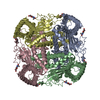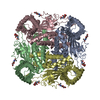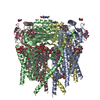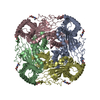[English] 日本語
 Yorodumi
Yorodumi- PDB-5t4d: Cryo-EM structure of Polycystic Kidney Disease protein 2 (PKD2), ... -
+ Open data
Open data
- Basic information
Basic information
| Entry | Database: PDB / ID: 5t4d | ||||||
|---|---|---|---|---|---|---|---|
| Title | Cryo-EM structure of Polycystic Kidney Disease protein 2 (PKD2), residues 198-703 | ||||||
 Components Components | hPKD:198-703, Polycystin-2 | ||||||
 Keywords Keywords | METAL TRANSPORT /  TRP channel / TRP channel /  PKD2 / PKD2 /  nanodisc / TRPP nanodisc / TRPP | ||||||
| Function / homology |  Function and homology information Function and homology informationdetection of nodal flow / metanephric smooth muscle tissue development / metanephric cortex development / metanephric cortical collecting duct development / metanephric distal tubule development /  polycystin complex / mesonephric tubule development / mesonephric duct development / : / metanephric part of ureteric bud development ...detection of nodal flow / metanephric smooth muscle tissue development / metanephric cortex development / metanephric cortical collecting duct development / metanephric distal tubule development / polycystin complex / mesonephric tubule development / mesonephric duct development / : / metanephric part of ureteric bud development ...detection of nodal flow / metanephric smooth muscle tissue development / metanephric cortex development / metanephric cortical collecting duct development / metanephric distal tubule development /  polycystin complex / mesonephric tubule development / mesonephric duct development / : / metanephric part of ureteric bud development / determination of liver left/right asymmetry / renal tubule morphogenesis / metanephric ascending thin limb development / HLH domain binding / basal cortex / metanephric mesenchyme development / metanephric S-shaped body morphogenesis / renal artery morphogenesis / positive regulation of inositol 1,4,5-trisphosphate-sensitive calcium-release channel activity / migrasome / cilium organization / VxPx cargo-targeting to cilium / detection of mechanical stimulus / regulation of calcium ion import / polycystin complex / mesonephric tubule development / mesonephric duct development / : / metanephric part of ureteric bud development / determination of liver left/right asymmetry / renal tubule morphogenesis / metanephric ascending thin limb development / HLH domain binding / basal cortex / metanephric mesenchyme development / metanephric S-shaped body morphogenesis / renal artery morphogenesis / positive regulation of inositol 1,4,5-trisphosphate-sensitive calcium-release channel activity / migrasome / cilium organization / VxPx cargo-targeting to cilium / detection of mechanical stimulus / regulation of calcium ion import /  cation channel complex / cation channel complex /  calcium-induced calcium release activity / muscle alpha-actinin binding / placenta blood vessel development / voltage-gated monoatomic ion channel activity / cellular response to hydrostatic pressure / outward rectifier potassium channel activity / voltage-gated monoatomic cation channel activity / non-motile cilium / cellular response to fluid shear stress / cellular response to osmotic stress / calcium-induced calcium release activity / muscle alpha-actinin binding / placenta blood vessel development / voltage-gated monoatomic ion channel activity / cellular response to hydrostatic pressure / outward rectifier potassium channel activity / voltage-gated monoatomic cation channel activity / non-motile cilium / cellular response to fluid shear stress / cellular response to osmotic stress /  voltage-gated sodium channel activity / inorganic cation transmembrane transport / voltage-gated sodium channel activity / inorganic cation transmembrane transport /  actinin binding / transcription regulator inhibitor activity / actinin binding / transcription regulator inhibitor activity /  motile cilium / determination of left/right symmetry / neural tube development / aorta development / protein heterotetramerization / ciliary membrane / branching involved in ureteric bud morphogenesis / negative regulation of G1/S transition of mitotic cell cycle / spinal cord development / heart looping / cytoplasmic side of endoplasmic reticulum membrane / motile cilium / determination of left/right symmetry / neural tube development / aorta development / protein heterotetramerization / ciliary membrane / branching involved in ureteric bud morphogenesis / negative regulation of G1/S transition of mitotic cell cycle / spinal cord development / heart looping / cytoplasmic side of endoplasmic reticulum membrane /  voltage-gated potassium channel activity / cell surface receptor signaling pathway via JAK-STAT / voltage-gated potassium channel activity / cell surface receptor signaling pathway via JAK-STAT /  potassium channel activity / centrosome duplication / sodium ion transmembrane transport / negative regulation of ryanodine-sensitive calcium-release channel activity / potassium channel activity / centrosome duplication / sodium ion transmembrane transport / negative regulation of ryanodine-sensitive calcium-release channel activity /  voltage-gated calcium channel activity / embryonic placenta development / monoatomic cation channel activity / cellular response to cAMP / release of sequestered calcium ion into cytosol / potassium ion transmembrane transport / cellular response to calcium ion / voltage-gated calcium channel activity / embryonic placenta development / monoatomic cation channel activity / cellular response to cAMP / release of sequestered calcium ion into cytosol / potassium ion transmembrane transport / cellular response to calcium ion /  cytoskeletal protein binding / basal plasma membrane / ciliary basal body / liver development / establishment of localization in cell / lumenal side of endoplasmic reticulum membrane / calcium ion transmembrane transport / protein tetramerization / cytoskeletal protein binding / basal plasma membrane / ciliary basal body / liver development / establishment of localization in cell / lumenal side of endoplasmic reticulum membrane / calcium ion transmembrane transport / protein tetramerization /  phosphoprotein binding / cytoplasmic vesicle membrane / phosphoprotein binding / cytoplasmic vesicle membrane /  cilium / intracellular calcium ion homeostasis / cilium / intracellular calcium ion homeostasis /  mitotic spindle / mitotic spindle /  Wnt signaling pathway / cellular response to reactive oxygen species / calcium ion transport / positive regulation of nitric oxide biosynthetic process / cell-cell junction / Wnt signaling pathway / cellular response to reactive oxygen species / calcium ion transport / positive regulation of nitric oxide biosynthetic process / cell-cell junction /  lamellipodium / regulation of cell population proliferation / lamellipodium / regulation of cell population proliferation /  heart development / heart development /  ATPase binding / positive regulation of cytosolic calcium ion concentration / protein homotetramerization / basolateral plasma membrane / transmembrane transporter binding / ATPase binding / positive regulation of cytosolic calcium ion concentration / protein homotetramerization / basolateral plasma membrane / transmembrane transporter binding /  regulation of cell cycle / negative regulation of cell population proliferation / regulation of cell cycle / negative regulation of cell population proliferation /  signaling receptor binding / signaling receptor binding /  calcium ion binding / endoplasmic reticulum membrane / positive regulation of gene expression / calcium ion binding / endoplasmic reticulum membrane / positive regulation of gene expression /  Golgi apparatus / Golgi apparatus /  endoplasmic reticulum / protein homodimerization activity / positive regulation of transcription by RNA polymerase II / extracellular exosome endoplasmic reticulum / protein homodimerization activity / positive regulation of transcription by RNA polymerase II / extracellular exosomeSimilarity search - Function | ||||||
| Biological species |   Homo sapiens (human) Homo sapiens (human) | ||||||
| Method |  ELECTRON MICROSCOPY / ELECTRON MICROSCOPY /  single particle reconstruction / single particle reconstruction /  cryo EM / Resolution: 3 Å cryo EM / Resolution: 3 Å | ||||||
 Authors Authors | Shen, P.S. / Yang, X. / DeCaen, P.G. / Liu, X. / Bulkley, D. / Clapham, D.E. / Cao, E. | ||||||
 Citation Citation |  Journal: Cell / Year: 2016 Journal: Cell / Year: 2016Title: The Structure of the Polycystic Kidney Disease Channel PKD2 in Lipid Nanodiscs. Authors: Peter S Shen / Xiaoyong Yang / Paul G DeCaen / Xiaowen Liu / David Bulkley / David E Clapham / Erhu Cao /  Abstract: The Polycystic Kidney Disease 2 (Pkd2) gene is mutated in autosomal dominant polycystic kidney disease (ADPKD), one of the most common human monogenic disorders. Here, we present the cryo-EM ...The Polycystic Kidney Disease 2 (Pkd2) gene is mutated in autosomal dominant polycystic kidney disease (ADPKD), one of the most common human monogenic disorders. Here, we present the cryo-EM structure of PKD2 in lipid bilayers at 3.0 Å resolution, which establishes PKD2 as a homotetrameric ion channel and provides insight into potential mechanisms for its activation. The PKD2 voltage-sensor domain retains two of four gating charges commonly found in those of voltage-gated ion channels. The PKD2 ion permeation pathway is constricted at the selectivity filter and near the cytoplasmic end of S6, suggesting that two gates regulate ion conduction. The extracellular domain of PKD2, a hotspot for ADPKD pathogenic mutations, contributes to channel assembly and strategically interacts with the transmembrane core, likely serving as a physical substrate for extracellular stimuli to allosterically gate the channel. Finally, our structure establishes the molecular basis for the majority of pathogenic mutations in Pkd2-related ADPKD. | ||||||
| History |
|
- Structure visualization
Structure visualization
| Movie |
 Movie viewer Movie viewer |
|---|---|
| Structure viewer | Molecule:  Molmil Molmil Jmol/JSmol Jmol/JSmol |
- Downloads & links
Downloads & links
- Download
Download
| PDBx/mmCIF format |  5t4d.cif.gz 5t4d.cif.gz | 321.4 KB | Display |  PDBx/mmCIF format PDBx/mmCIF format |
|---|---|---|---|---|
| PDB format |  pdb5t4d.ent.gz pdb5t4d.ent.gz | 255.2 KB | Display |  PDB format PDB format |
| PDBx/mmJSON format |  5t4d.json.gz 5t4d.json.gz | Tree view |  PDBx/mmJSON format PDBx/mmJSON format | |
| Others |  Other downloads Other downloads |
-Validation report
| Arichive directory |  https://data.pdbj.org/pub/pdb/validation_reports/t4/5t4d https://data.pdbj.org/pub/pdb/validation_reports/t4/5t4d ftp://data.pdbj.org/pub/pdb/validation_reports/t4/5t4d ftp://data.pdbj.org/pub/pdb/validation_reports/t4/5t4d | HTTPS FTP |
|---|
-Related structure data
| Related structure data |  8354MC  8355C  8356C M: map data used to model this data C: citing same article ( |
|---|---|
| Similar structure data |
- Links
Links
- Assembly
Assembly
| Deposited unit | 
|
|---|---|
| 1 |
|
- Components
Components
| #1: Protein | Mass: 59429.145 Da / Num. of mol.: 4 Source method: isolated from a genetically manipulated source Source: (gene. exp.)   Homo sapiens (human) / Gene: PKD2, TRPP2 / Cell line (production host): HEK293S GnTI-/- / Production host: Homo sapiens (human) / Gene: PKD2, TRPP2 / Cell line (production host): HEK293S GnTI-/- / Production host:   Homo sapiens (human) / References: UniProt: Q13563 Homo sapiens (human) / References: UniProt: Q13563#2: Sugar | ChemComp-NAG /  N-Acetylglucosamine N-Acetylglucosamine |
|---|
-Experimental details
-Experiment
| Experiment | Method:  ELECTRON MICROSCOPY ELECTRON MICROSCOPY |
|---|---|
| EM experiment | Aggregation state: PARTICLE / 3D reconstruction method:  single particle reconstruction single particle reconstruction |
- Sample preparation
Sample preparation
| Component | Name: hPKD:198-703 / Type: COMPLEX / Entity ID: #1 / Source: RECOMBINANT | |||||||||||||||
|---|---|---|---|---|---|---|---|---|---|---|---|---|---|---|---|---|
| Source (natural) | Organism:   Homo sapiens (human) Homo sapiens (human) | |||||||||||||||
| Source (recombinant) | Organism:   Homo sapiens (human) / Cell: HEK293S GnTI-/- / Plasmid Homo sapiens (human) / Cell: HEK293S GnTI-/- / Plasmid : pFastbac1 : pFastbac1 | |||||||||||||||
| Buffer solution | pH: 7.4 | |||||||||||||||
| Buffer component |
| |||||||||||||||
| Specimen | Conc.: 2 mg/ml / Embedding applied: NO / Shadowing applied: NO / Staining applied : NO / Vitrification applied : NO / Vitrification applied : YES : YESDetails: Single particles embedded in lipid nanodiscs. This sample was monodisperse. | |||||||||||||||
| Specimen support | Grid material: COPPER / Grid mesh size: 400 divisions/in. / Grid type: Quantifoil | |||||||||||||||
Vitrification | Instrument: FEI VITROBOT MARK II / Cryogen name: ETHANE / Humidity: 80 % / Chamber temperature: 277 K / Details: blot for 7 seconds, -1 mm offset before plunging |
- Electron microscopy imaging
Electron microscopy imaging
| Experimental equipment |  Model: Tecnai Polara / Image courtesy: FEI Company |
|---|---|
| Microscopy | Model: FEI POLARA 300 |
| Electron gun | Electron source : :  FIELD EMISSION GUN / Accelerating voltage: 300 kV / Illumination mode: FLOOD BEAM FIELD EMISSION GUN / Accelerating voltage: 300 kV / Illumination mode: FLOOD BEAM |
| Electron lens | Mode: BRIGHT FIELD Bright-field microscopy / Nominal magnification: 31000 X / Calibrated magnification: 41132 X / Nominal defocus max: 2400 nm / Nominal defocus min: 600 nm / Cs Bright-field microscopy / Nominal magnification: 31000 X / Calibrated magnification: 41132 X / Nominal defocus max: 2400 nm / Nominal defocus min: 600 nm / Cs : 2 mm : 2 mm |
| Specimen holder | Cryogen: NITROGEN |
| Image recording | Average exposure time: 0.2 sec. / Electron dose: 1.35 e/Å2 / Detector mode: SUPER-RESOLUTION / Film or detector model: GATAN K2 SUMMIT (4k x 4k) / Num. of grids imaged: 1 / Num. of real images: 1500 |
| Image scans | Movie frames/image: 40 |
- Processing
Processing
| Software | Name: PHENIX / Version: 1.10.1_2155: / Classification: refinement | ||||||||||||||||||||||||||||||||||||
|---|---|---|---|---|---|---|---|---|---|---|---|---|---|---|---|---|---|---|---|---|---|---|---|---|---|---|---|---|---|---|---|---|---|---|---|---|---|
| EM software |
| ||||||||||||||||||||||||||||||||||||
| Image processing | Details: superresolution mode | ||||||||||||||||||||||||||||||||||||
CTF correction | Type: PHASE FLIPPING AND AMPLITUDE CORRECTION | ||||||||||||||||||||||||||||||||||||
| Particle selection | Num. of particles selected: 368032 / Details: semi-automated particle picking | ||||||||||||||||||||||||||||||||||||
| Symmetry | Point symmetry : C4 (4 fold cyclic : C4 (4 fold cyclic ) ) | ||||||||||||||||||||||||||||||||||||
3D reconstruction | Resolution: 3 Å / Resolution method: FSC 0.143 CUT-OFF / Num. of particles: 93805 / Algorithm: FOURIER SPACE / Num. of class averages: 1 / Symmetry type: POINT | ||||||||||||||||||||||||||||||||||||
| Refine LS restraints |
|
 Movie
Movie Controller
Controller









 PDBj
PDBj



